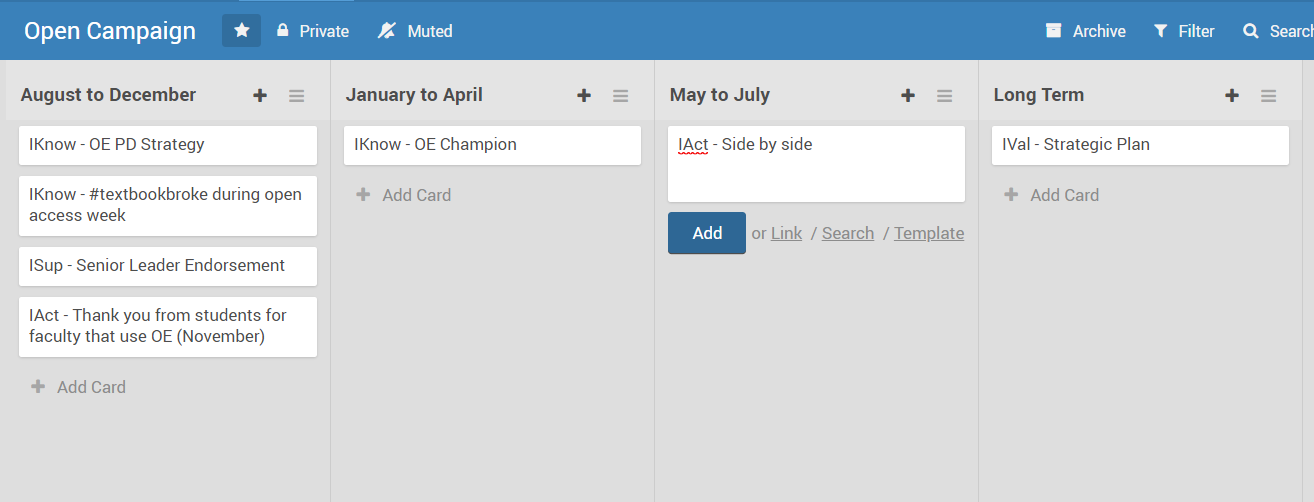Appendix 8: Kanban and Project Management
Ross McKerlich
At first glance, it might seem that the fields of project management and sales and marketing do not mix with the world of open education. Profit and the social justice origins of open education may seem like oil and water, yet process and messaging have an important role to play in open education. Open education also has its roots in the open source movement commonly associated with the software industry, where project management tools are well used. This chapter describes Kanban, a common project management tool, and how it might be used in conjunction with sales and marketing strategies to further advance open education at an institution.
Kanban
Kanban is both a project management tool and a workflow management tool. It has its origins in the automotive industry (see the Toyota Production System) in Japan. The word “kanban” — Japanese for “signboard” or “billboard” — is intended as a visual, real-time information system. At the most basic level, it tracks workflow using task cards in three columns: To Do, In Progress, and Done. As tasks progress, they can be moved from one column to the next, allowing for clear communication with all involved in the project.
Open education working groups can use Kanban to better focus and coordinate their work by allowing individuals access to a shared Kanban board, so everyone knows who is working on what and what stage they are at in the process. This online tool also minimizes time and geography barriers, factors that often affect open education working groups.
There are several Kanban tools available. One that is free and open source is called Wekan, which is available as an app on the Opensource Apps for Educators section of the OpenETC site. A group of B.C. educators, technologists, and instructional designers support this app framework hosted on BCNET EduCloud. A free account must be created to access the Wekan app, along with more than 50 other apps. The proprietary version from Microsoft 365 comes with a planner, which is great for integration with Calendar and Teams.
Kanban and the Sales Pipeline
In sales customer relationship management systems, the stages of a sale are collectively called a pipeline. Open education advocacy work has some similarity to sales, because in the end, faculty must switch products — in this case, from a publisher resource to an open educational resource (OER). There is often a journey to convince faculty to go from using a publisher resource to an open resource, and this movement can be tracked using a Kanban board. To assist with identifying where faculty are on adopting, creating, or promoting open education, this open pipeline is suggested:
- Promising Prospect
- Probing Possibility
- Active Adopter
- Contributing Creator
- Passionate Promoter
A Promising Prospect could be an English professor you know who is teaching a class for which there is a suitable OER available. You might approach them, suggesting that they use an OER.
As a Probing Possibility, the English professor is interested, but needs a bit more convincing and to do further evaluation of the OER to see if it is suitable.
When the English professor adopts the OER, they become an Active Adopter.
If they use the OER and find they want to adapt it or create something new, the English professor becomes a Contributing Creator.
Finally, as an adopter or a creator, the English professor could become a Passionate Promoter and advocate for OER in their institution and beyond.
Relationships vs. Pipeline
It should be noted that OER advocacy in an institution is all about relationships, and people should not be labelled by a pipeline stage. It can be useful, however, to identify and acknowledge where your colleagues are at in the open pipeline in order to track progress.
Just like the sales connection described above, the importance of messaging and communication is essential to advocating for open at a post-secondary institution. Some strategies will work, and others may fall flat, but planning is essential. Kanban can help in this area as well, with columns that are descriptive of time periods and cards that describe open strategies and define how they might be executed.

The strategies, for example, could be connected to institutional values, knowledge, action, and policy. The combination of the two tools — sales pipeline and Kanban — could help streamline open education groups’ operations for the year ahead. A planning session in June or July, for instance, would still have to take place, but once the board was established, the campaigns could be easily executed and monitored.
Post-secondary institutions are dynamic environments, so there must be an element of flexibility in the campaigns, but the time frame design could help an open education group plan, execute, and evaluate open campaigns.
Also see 20 Questions to Ask about Open Education [PDF] and [fillable PDF]. These 20 yes or no questions cover institutional values, knowledge, support, action, and policy and will give the advocates in your institution an indication of where there might be some gaps. To address those gaps, see this searchable database of corresponding open education strategies.
Long Description
Open Campaign Kanban board long description: A Kanban board titled “Open Campaign.” Its columns describe time periods, and its cards define and describe open education advocacy strategies. The columns and cards are laid out as follows:
- August to December
- IKnow – OE PD Strategy
- IKnow – #textbookBroke during open access week
- ISup – Senior Leader Endorsement
- IAct – Thank you from students for faculty that use OE (November)
- January to April
- IKnow – OE Champion
- May to July
- IAct – Side by side
- Long Term
- IVal – Strategic Plan


